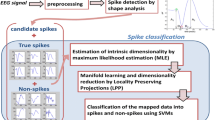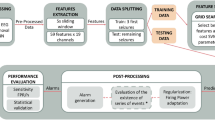Abstract
Localization of interictal spikes is an important clinical step in the pre-surgical assessment of pharmacoresistant epileptic patients. The manual selection of interictal spike periods is cumbersome and involves a considerable amount of analysis workload for the physician. The primary focus of this paper is to automate the detection of interictal spikes for clinical applications in epilepsy localization. The epilepsy localization procedure involves detection of spikes in a multichannel EEG epoch. Therefore, a multichannel Time–Frequency (T–F) entropy measure is proposed to extract features related to the interictal spike activity. Least squares support vector machine is used to train the proposed feature to classify the EEG epochs as either normal or interictal spike period. The proposed T–F entropy measure, when validated with epilepsy dataset of 15 patients, shows an interictal spike classification accuracy of 91.20%, sensitivity of 100% and specificity of 84.23%. Moreover, the area under the curve of Receiver Operating Characteristics plot of 0.9339 shows the superior classification performance of the proposed T–F entropy measure. The results of this paper show a good spike detection accuracy without any prior information about the spike morphology.







Similar content being viewed by others
References
WHO Media Center WHO | (2016) Epilepsy. World Health Organization
Barkley GL, Baumgartner C (2003) MEG and EEG in epilepsy. J Clin Neurophysiol 20:163–178. doi:10.1097/00004691-200305000-00002
Brodbeck V, Spinelli L, Lascano AM, Wissmeier M, Vargas MI, Vulliemoz S et al (2011) Electroencephalographic source imaging: a prospective study of 152 operated epileptic patients. Brain 134:2887–2897. doi:10.1093/brain/awr243
Park CJ, Seo JH, Kim D, Abibullaev B, Kwon H, Lee YH et al (2015) EEG source imaging in partial epilepsy in comparison with presurgical evaluation and magnetoencephalography. J Clin Neurol (Korea) 11:319–330. doi:10.3988/jcn.2015.11.4.319
Lu Y, Worrell GA, Zhang HC, Yang L, Brinkmann B, Nelson C et al (2014) Noninvasive imaging of the high frequency brain activity in focal epilepsy patients. IEEE Trans Biomed Eng 61:1660–1667. doi:10.1109/TBME.2013.2297332
Lee C, Kim JS, Jeong W, Chung CK (2014) Usefulness of interictal spike source localization in temporal lobe epilepsy: electrocorticographic study. Epilepsy Res 108:448–458. doi:10.1016/j.eplepsyres.2013.12.008
Wang G, Worrell G, Yang L, Wilke C, He B (2011) Interictal spike analysis of high-density eeg in patients with partial epilepsy. Clin Neurophysiol 122:1098–1105. doi:10.1016/j.clinph.2010.10.043
Zwoliński P, Roszkowski M, Zygierewicz J, Haufe S, Nolte G, Durka PJ (2010) Open database of epileptic EEG with MRI and postoperational assessment of foci–a real world verification for the EEG inverse solutions. Neuroinformatics 8:285–299. doi:10.1007/s12021-010-9086-6
Scherg M, Ille N, Weckesser D, Ebert A, Ostendorf A, Boppel T et al (2012) Fast evaluation of interictal spikes in long-term EEG by hyper-clustering. Epilepsia 53:1196–1204. doi:10.1111/j.1528-1167.2012.03503.x
Acharya UR, Fujita H, Sudarshan VK, Bhat S, Koh JEW (2015) Application of entropies for automated diagnosis of epilepsy using EEG signals: a review. Knowl-Based Syst 88:85–96. doi:10.1016/j.knosys.2015.08.004
Shen CP, Liu ST, Zhou WZ, Lin FS, Lam AYY, Sung HY et al (2013) A physiology-based seizure detection system for multichannel EEG. PLoS ONE. doi:10.1371/journal.pone.0065862
Xiang J, Li C, Li H, Cao R, Wang B, Han X et al (2015) The detection of epileptic seizure signals based on fuzzy entropy. J Neurosci Methods 243:18–25. doi:10.1016/j.jneumeth.2015.01.015
Zhanfeng Ji, Sugi T, Goto S, Xingyu Wang, Ikeda A, Nagamine T et al (2011) An Automatic spike detection system based on elimination of false positives using the large-area context in the scalp EEG. IEEE Trans Biomed Eng 58:2478–2488. doi:10.1109/TBME.2011.2157917
Faust O, Acharya UR, Adeli H, Adeli A (2015) Wavelet-based EEG processing for computer-aided seizure detection and epilepsy diagnosis. Seizure 26:56–64. doi:10.1016/j.seizure.2015.01.012
Bhardwaj S, Jadhav P, Adapa B, Acharyya A, Naik GR (2015) Online and automated reliable system design to remove blink and muscle artefact in EEG. 37th Annual international conference of the IEEE engineering in medicine and biology society (EMBC), IEEE; 2015, pp. 6784–6787. doi:10.1109/EMBC.2015.7319951
Jadhav PN, Shanamugan D, Chourasia A, Ghole AR, Acharyya A, Naik G (2014) Automated detection and correction of eye blink and muscular artefacts in EEG signal for analysis of Autism Spectrum Disorder. 36th Annual international conference of the IEEE engineering in medicine and biology society, vol. 2014, IEEE; 2014, pp. 1881–1884. doi:10.1109/EMBC.2014.6943977
Feis RA, Smith SM, Filippini N, Douaud G, Dopper EGP, Heise V et al (2015) ICA-based artifact removal diminishes scan site differences in multi-center resting-state fMRI. Front Neurosci 9:395. doi:10.3389/fnins.2015.00395
Ayoubian L, Lacoma H, Gotman J (2013) Automatic seizure detection in SEEG using high frequency activities in wavelet domain. Med Eng Phys 35:319–328. doi:10.1016/j.medengphy.2012.05.005
Tadel F, Baillet S, Mosher JC, Pantazis D, Leahy RM (2011) Brainstorm: a user-friendly application for MEG/EEG analysis. Comput Intell Neurosci. doi:10.1155/2011/879716
Deng Y, Bao F, Deng X, Wang R, Kong Y, Dai Q (2016) Deep and structured robust information theoretic learning for image analysis. IEEE Transact Image Process. doi:10.1109/TIP.2016.2588330
Kong Y, Deng Y, Dai Q (2015) Discriminative clustering and feature selection for brain MRI segmentation. IEEE Signal Process Lett 22:573–577. doi:10.1109/LSP.2014.2364612
Acharya UR, Molinari F, Sree SV, Chattopadhyay S, Ng KH, Suri JS (2012) Automated diagnosis of epileptic EEG using entropies. Biomed Signal Process Control 7:401–408. doi:10.1016/j.bspc.2011.07.007
Zhang Y, Liu B, Ji X, Huang D (2016) Classification of EEG signals based on autoregressive model and wavelet packet decomposition. Neural Processing Lett. doi:10.1007/s11063-016-9530-1
Chai R, Naik G, Nguyen TN, Ling S, Tran Y, Craig A, et al (2016) Driver Fatigue classification with independent component by entropy rate bound minimization analysis in an EEG-based System. IEEE J Biomed Health Inform. doi:10.1109/JBHI.2016.2532354.
Pincus SM (1991) Approximate entropy as a measure of system complexity. Proc Natl Acad Sci USA 88:2297–2301. doi:10.1073/pnas.88.6.2297
Bajaj V, Pachori R (2011) Application of the sample entropy for discrimination between seizure and seizure-free EEG signals. Proceedings of the fifth Indian international conference on artificial intelligence application :1232–1237
Richman JS, Moorman JR (2000) Physiological time-series analysis using approximate entropy and sample entropy. Am J Physiol Heart Circ Physiol 278:H2039–H2049. doi:10.1103/physreva.29.975
Chen W, Wang Z, Xie H, Yu W (2007) Characterization of surface EMG signal based on fuzzy entropy. IEEE Trans Neural Syst Rehabil Eng 15:266–272. doi:10.1109/TNSRE.2007.897025
Rodin E, Constantino T, Rampp S, Wong PK (2009) Spikes and epilepsy. Clin EEG Neurosci 40:288–299. doi:10.1177/155005940904000411.
Pohjalainen J, Räsänen O, Kadioglu S (2015) Feature selection methods and their combinations in high-dimensional classification of speaker likability, intelligibility and personality traits. Comput Speech Lang 29:145–171. doi:10.1016/j.csl.2013.11.004
Chai R, Tran Y, Naik GR, Nguyen TN, Ling SH, Craig A et al (2016) Classification of EEG based-mental fatigue using principal component analysis and Bayesian neural network. 38th Annual international conference of the IEEE engineering in medicine and biology society (EMBC), IEEE; 2016 pp. 4654–4657. doi:10.1109/EMBC.2016.7591765
Shin Y, Lee S, Ahn M, Cho H, Jun SC, Lee H-N. (2015) Noise robustness analysis of sparse representation based classification method for non-stationary EEG signal classification. Biomed Signal Process Control 21:8–18. doi:10.1016/j.bspc.2015.05.007
Chua KC, Chandran V, Acharya UR, Lim CM (2011) Application of higher order spectra to identify epileptic EEG. J Med Syst 35:1563–1571. doi:10.1007/s10916-010-9433-z
Lu N, Li T, Pan J, Ren X, Feng Z, Miao H (2015) Structure constrained semi-nonnegative matrix factorization for EEG-based motor imagery classification. Comput Biol Med 60:32–39. doi:10.1016/j.compbiomed.2015.02.010
Sharma R, Pachori RB, Acharya UR (2015) Application of entropy measures on intrinsic mode functions for the automated identification of focal electroencephalogram signals. Entropy 17:669–691. doi:10.3390/e17020669
Suykens JAK, Vandewalle J (1999) Least squares support vector machine classifiers. Neural Process Lett 9:293–300. doi:10.1023/A:1018628609742
Acharya UR, Vinitha Sree S, Swapna G, Martis RJ, Suri JS (2013) Automated EEG analysis of epilepsy: a review. Knowl-Based Syst 45:147–165. doi:10.1016/j.knosys.2013.02.014
İnan ZH, Kuntalp M (2007) A study on fuzzy C-means clustering-based systems in automatic spike detection. Comput Biol Med 37:1160–1166. doi:10.1016/j.compbiomed.2006.10.010
Chavakula V, Sánchez Fernández I, Peters JM, Popli G, Bosl W, Rakhade S et al (2013) Automated quantification of spikes. Epilepsy Behav 26:143–152. doi:10.1016/j.yebeh.2012.11.048
Seker Yilmaz B, Okuyaz C, Komur M (2013) Predictors of intractable childhood epilepsy. Pediatr Neurol 48:52–55. doi:10.1016/j.pediatrneurol.2012.09.008
Acknowledgements
The authors would like to express sincere thanks to the reviewers for providing appropriate suggestions to improve the quality of the manuscript.
Author information
Authors and Affiliations
Corresponding author
Ethics declarations
Conflict of interest
None Declared.
Ethical approval
This study used publicly available epilepsy database obtained from http://eeg.pl/epi. It is available to researchers guided by the norms of ‘Information sharing agreement’ described in the works of Piotr Zwoliński et al.
Rights and permissions
About this article
Cite this article
Thanaraj, P., Parvathavarthini, B. Multichannel interictal spike activity detection using time–frequency entropy measure. Australas Phys Eng Sci Med 40, 413–425 (2017). https://doi.org/10.1007/s13246-017-0550-6
Received:
Accepted:
Published:
Issue Date:
DOI: https://doi.org/10.1007/s13246-017-0550-6




